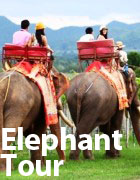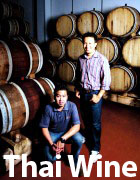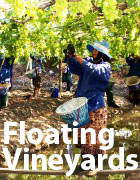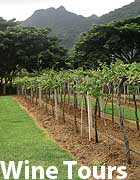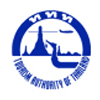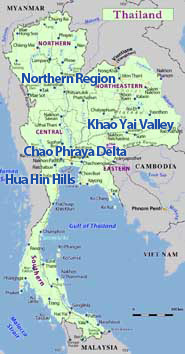Best VIP Private Wine Tours of Thailand
Thai Wine and Thailand Winery Guide
The History of Thai Wines and Thailand Wineries
The late Dr. Chaijudh Karnasuta is revered as the 'father' of Thailand's grape wine industry. He was the first to make his vision of growing wine grapes in Thailand to produce wine, a reality.
He planted the first vines at Chateau de Loei in 1991, and enjoyed his first commercial harvest in 1995. This was followed by the planting of the PB Valley vineyards in 1992, Chateau des Brumes in 1997 and GranMonte in 1999.
New Latitude Wines of Thailand
Traditionally, grapes for wine-making have been grown between the 30th and 50th parallels in both the northern and southern hemispheres. Thailand has pioneered the production of what is referred to as 'New Latitude' wines, made from grapes grown in a narrow band in the north between the 14th to 18th parallels.
The Wine Producing Regions
Thailand has three main wine-producing regions.
The first is the northern latitude of 17-18 with clay loam soil. Daytime temperatures during harvest are 20-25 degrees celsius, dropping to 12 celsius at night. It is home to Chateau de Loei, in the Phu Rua Valley, at an altitude of 600 metres above sea level; and Chateau Shala One, in Phichit province, at 300 metres above sea level.
The second is the Khao Yai Wine Region at the northern latitude of 14.3, similarly with a clay loam soil. On the western side are the vineyards of PB Valley and GranMonte, at altitudes of 300-350 metres above sea level, while on the extreme eastern boundary is Chateau des Brumes, with vineyards at an elevation of over 500 metres above sea level. The region has morning temperatures of 15-20 degrees celsius during harvest time.
The third is the Chao Phraya delta, home to Siam Winery, producers of Monsoon Valley. This is currently the most southerly wine region at the northern latitude of 14, at an elevation of 5 metres above sea level with daytime temperatures ranging from 18-22 degrees Celsius.
Thailand Winery and Thai Wine Producers
Chateau de Loei
Chateau de Loei is located at Phu Rua in Loei province, 460 kilometres northeast of Bangkok. "A plateau of rolling golden hills -- a chunk of southern France carved out and shipped to Asia," was how Time Asia described the vineyards. During 2004, they harvested 500 tonnes of grapes, mainly Chenin Blanc and Shiraz. Chenin Blanc was selected because it is slightly sweet and goes well with spicy Thai food. The same grape is used for a dry chenin made from the pick of the fruit, a botrytis sauterne-style dessert wine and a sparking methode Champagnoise. A reserve shiraz enhanced by new American oak is the Chateau's flagship red wine but most of the shiraz goes into a soft, friendly, easy-to-drink dry red, though the same fruit is also used for a fresh, clean lively rose. The wines are made under the guidance of two high-flying winemakers, Dorham Mann from Australia and Vincent Careme from Vouvray in the Loire Valley (the home of Chenin Blanc), providing a balance of New and Old World expertise. The mentors have trained and provide technical support to two Thai winemakers Nattawat Limwatcharakorn and Siripokanun Mingmuang.
Chateau Shala One
Shala One Vineyard at 'Kajorn Farm' is located at King Amphoe Dong Charoen, Phichit Province. Of the total area of 230 rai, 30 rai are planted with table grapes and 200 rai with wine grapes. Thai wine drinkers generally prefer red to white wines and this vineyard produces almost exclusively red wines, 150 rai under Shiraz, 16.18 Rai under Tempranillo, 3.5 under Cabernet Sauvignon and 1.5 rai for Merlot production. They have two very small plots of chenin blanc and sauvignon blanc.
Village Farm Winery
Located at the eastern extremity of Khao Yai National park, in the Wang Nam Keow Valley, Village Farm produces two distinct ranges of wines. Firstly Chateau des Brumes ('Castle in the Mist' in English, the name inspired by the fine mist that hangs in the valley during early morning) with a traditional French style and character and, Village Thai (the name used for export but marketed as Village Farm to the Thai domestic market) wines with a more fresh, fruity, contemporary New World style. The oldest vines on the East plantation are seven years old. The fruit is sourced from two vineyards both 80 acres, one at Village Farm winery, the second 18 kilometres away. As it is essential to harvest the fruit at a cool temperature, this is undertaken at midnight, shuttling the fruit back to the vinery within one hour of picking. Jacques Bacou, a French winemaker who visits three times a year, makes the wines. "The problem with making wine in Thailand is not just the warm temperature," Jacques explains, "but the rain and topography. At Wang Nam Keow the climate is rather dry and we have found nice hills with good natural drainage. We are able to get good maturity at harvest time with concentration and balanced sugar levels. Very low acidity is a minor problem." As the crop arrives from the vineyard, Jacques is the gatekeeper at the winery. He is ruthlessly strict about fruit selection, only allowing the best grapes to enter to be made into Chateau des Brumes.
PB Valley, Khao Yai Winery
The vineyard nestles in a beautiful 800-acre-valley and is the oldest of the three in the Khao Yai Wine Region. Commercial production of wine began in 1991 by owner Piya Bhirombhadi, with assistance from German oenologist Wolfgang W. Schaefer. The vines are from France, Spain, Italy and Germany producing Shiraz, Tempranillo, Chenin Blanc and Colombard varieties. In 1997, Prayut Piengbunta was appointed the first Winemaker and Manager of the vineyard, having completed studying winemaking in Germany in October 1997. He is responsible for the 3,000 state-of-the-art winery with the capacity to handle 600,000 bottles a year. The first harvest was in 1998, although not a great vintage. However the 1999 vintage was proof that quality wine could be successfully produced. Since 2002 the Khao Yai Reserve 1999 has been served on board Thai Airways International flights. The Khao Yai Reserve Shiraz 2000 was also selected and served at the gala dinner for the Heads of States at the APEC 2003 conference, hosted by the Prime Minister of Thailand, Dr. Thaksin Shinawatra. Previous vintages have been predominantly Chenin Blanc and Shiraz, but earlier this year (2005) they released Thailand's first red wine based on Tempranillo in addition to the established Shiraz. It also coincided with their launch of 'Pirom', a high-end quality wine.
GranMonte Estate
Set in 40 acres of vineyard, with 25 planted with Shiraz, 10 with Chenin Blanc and the remaining five with the valuable cash crop of table grapes. Their first vines of Syrah and Chenin Blanc from French rootstock were planted in early 1999. Arrival at the estate is memorable, sweeping into the driveway and looking out onto an almost model vineyard. The garden in between the rows of vines is immaculately trimmed, everything neatly labelled in easy-to-read corporate text set against a white board. Located at the far end of the drive is a single storey modern Manor House, the weekend home of Visooth and Sakuna Lohithnavy. In choosing the vineyard's name, the mountainous area was an incorporated element. After much discussion, Khun Malinee, Visooth's former sister-in-law, now living in Rome, suggested Grande Monte, Italian for big mountai. This was quickly shortened to GranMonte, with a capital M in the middle. The Italian connections were to continue with other names on the property, the cellar door shop Montino (small mountain, the reserve of GranMonte) and then VinCotto, the vineyards restaurant where Sakuna indulges in her passion for cooking. It is worth the drive just for lunch. For the premiere vintage in 2001,, the vineyard produced 20 tonnes of red wine grapes yielding 20,000 bottles and six tonnes of white wine grapes yielding 6,000 bottles. In the following year, production increased 25%. It takes on average one kilo of grapes to make a bottle of GranMonte wine.
Siam Winery
Theirs is a slightly different story that ends in much the same place. Chalerm Yoovidhya founded Siam Winery as a family company in 1982 following on from its success with the iconic Red Bull energy drink. Realising there was little wine choice in the Thai market at that time, he launched Spy Wine Cooler, a light wine-based drink enhanced with Thai spices, designed to suit the Thai palate and humid climate. In 1997, Chalerm decided he wanted to make wine in Thailand and recruited Laurent Metge-Toppin an oenologist from Montpellier. The brief was to create a wine for both the domestic and tourist market to go with spicy Thai food. The result was Chatemp. Siam Winery did not then have its own vineyards and was buying Malaga Blanc for white wines, the local dark skinned Pok Dum or Black Queen grapes with Shiraz and Black Muscat from farmers in the Chao Phraya delta, an hour's drive southwest of Bangkok. The 10,000 acres of vineyards are unique and spectacular -- they are floating. Planted on hummocks that sit on lakes, the grapes flourish in the rich alluvial soil that washes down the mountain during the monsoon. Here again, we see night harvesting. The pickers have to cross the canals by bridge or boat. The grapes are then paddled to the nearby winery. The next generation of wine from Siam Winery was Monsoon Valley, remained faithful to the original philosophy but creating three very distinctive wines. The Monsoon Valley White is a fresh dry wine made from Malaga Blanc grapes. The Red is made from 70% Pok Dum or Black Queen grapes and 30% Shiraz. The rose is produced from a blend of Pok Dum and Malaga Blanc. These are Thai wines made from Thai grapes to go with Thai food, a totally Thai product. Although the Gregorian calendar is widely used in Thailand, a conscious decision was made to put the Thai (Buddhist Era) year on the bottle.
Mae Chan Winery
Mae Chan Valley is located in Amphoe Maechan, Chiang Rai, Northern Thailand. It is surrounded with beautiful atmosphere of vineyard, tropical trees and plants and a lake which you will cross on your trip to the winery and vineyards. Mae Chan Winery select and plant the highest quality Shiraz wine grapes imported from Australia for making the Thai red wine. Mae Chan Winery red wine have received "the Best of the Best of Chiang Rai" recognition from wine critiques. Mae Chan Winery Shiraz is grown on the hillside vineyard in Chiang Rai Province in the northern part of Thailand. To create the full-bodied red wine, Mae Chan Winery selected the best cuvee from the two-year harvests. Through aging in oak barrels, Mae Chan wine has a unique character. It has an attractive red color, elegant aromas and soft balance of flavors.
Grape Harvest Time
Growing conditions allow for two harvests a year, the first and superior harvest in February, and the second during the rainy season in September. In the early days, the mere thought of having twice as much fruit delighted the producers. However they soon realised that it was a high volume of poor quality fruit, and not what they wanted. By pruning back the second crop, the overall quality of the first crop increases.
Fruit Wines
Chiang Rai Winery
In addition to making wine from grapes, Thailand has an abundance of tropical and subtropical raw material for the production of fruit wines which have been made during the past couple of years. Some of the popular choices include pineapple, Roselle, passion fruit and mulberry. Thai medicinal plants and herbs are being combined with fruit to make the six-wine 'La Sante' range produced by Chiang Rai Winery. Black Krachai wine is made from the krachai plant and is considered suitable to accompany herb-based dishes and grilled food. This health drink refreshes and revitalises the body. Wine produced from the santol plant has high levels of tannic acid and anti-oxidants. It is ideal with all seafood, steamed dishes and, of course, tom yam koong. Thai noni wine has a delicate taste which goes well with spicy salads, herbs and, in particular, som tam papaya salad. Red fruit wines, from herbs and spices grown 500-600 metres above sea-level in a cool climate, combine mamao, santol and roselle and are recommended with grilled food and spicy salads. Thai fruit wines are special for their unique taste and health qualities: drinking them is not just for enjoyment but is also good for health.
Touring the Wineries and Wine Tasting
Enjoy luxury Thai wine tours and Thailand winery tours with VIP Private wine tours of Thailand. Experience the wine-making process, walk around the vines to see how the grapes are grown, discover how the Thai wines are made and then taste them where they were born.
